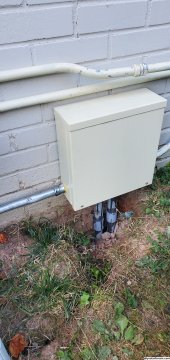BlueMarblePA
Solar Enthusiast
I finished installing diy a grid tie 7.6kw solaredge used system with 40amp back feed breaker and 9.8kw pv. With the help of this forum, I received PTO in April 2023.
Now, I want to install a solark 15k so that I can add more pv to the system and batteries and have backup should the grid go down. I received a quote from a reputable dealer for $14k just to install the solark without a bypass, without batteries and without additional pv. Seems like $7k for the inverter and $7k in labor plus miscellaneous parts.
I am trying to figure how to do this myself. I have 400amp service CL320 with double lug split to two 200amp panels in the basement sitting side by side. I only need one of the 200amp panels in a grid down situation. Hence, this one panel is the one I want to have a solark 15k.
I don't have experience pulling a meter from the service entrance, and I am sure my POCO would not approve. But I know the $14k quote specifically says that since we are not upgrading the solar pv panels, they are just going to pull the meter themselves and install.
My question after studying the wiring diagram from solark is how to split the 240v 4/0 service entrance cable after the fused disconnect? It seems that the line voltage can go to the LINE IN of the solark 15k and the Line side of the 200amp manual bypass switch.
I am thinking of hiring an electrician just to wire the fused disconnect and the double pole 200amp three way disconnect, so that I can just buy the solark 15k myself and save some cash.
Your help with pictures would be greatly appreciated? Do I just put a double lug at the fused disconnect?
Also which box becomes the neutral to ground bond? I assume it is no longer the main electrical panel, since the first means of disconnect is now the fused disconnect
Now, I want to install a solark 15k so that I can add more pv to the system and batteries and have backup should the grid go down. I received a quote from a reputable dealer for $14k just to install the solark without a bypass, without batteries and without additional pv. Seems like $7k for the inverter and $7k in labor plus miscellaneous parts.
I am trying to figure how to do this myself. I have 400amp service CL320 with double lug split to two 200amp panels in the basement sitting side by side. I only need one of the 200amp panels in a grid down situation. Hence, this one panel is the one I want to have a solark 15k.
I don't have experience pulling a meter from the service entrance, and I am sure my POCO would not approve. But I know the $14k quote specifically says that since we are not upgrading the solar pv panels, they are just going to pull the meter themselves and install.
My question after studying the wiring diagram from solark is how to split the 240v 4/0 service entrance cable after the fused disconnect? It seems that the line voltage can go to the LINE IN of the solark 15k and the Line side of the 200amp manual bypass switch.
I am thinking of hiring an electrician just to wire the fused disconnect and the double pole 200amp three way disconnect, so that I can just buy the solark 15k myself and save some cash.
Your help with pictures would be greatly appreciated? Do I just put a double lug at the fused disconnect?
Also which box becomes the neutral to ground bond? I assume it is no longer the main electrical panel, since the first means of disconnect is now the fused disconnect










